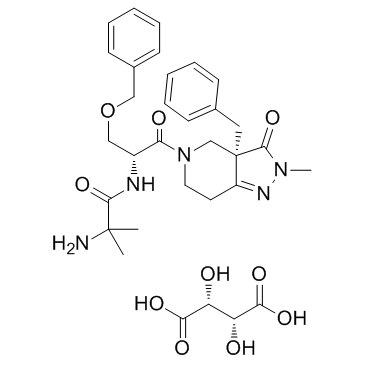193273-69-7
| Name | (2R,3R)-2,3-Dihydroxysuccinic acid-N-{2-[(3aS)-3a-benzyl-2-meth yl-3-methylene-2,3,3a,4,6,7-hexahydro-5H-pyrazolo[4,3-c]pyridin-5 -yl]-1-(benzyloxy)-2-oxoethyl}-2-methylalaninamide (1:1) |
|---|---|
| Synonyms |
Capromorelin tartrate
CP 424391-18 Capromorelin (Tartrate) |
| Description | Capromorelin Tartrate is an orally active, potent growth hormone secretagogue receptor (GHSR) agonist, with Ki of 7 nM for hGHS-R1a. |
|---|---|
| Related Catalog | |
| Target |
Ki: 7 nM (hGHS-R1a)[2] |
| In Vitro | Capromorelin stimulates GH release in rat pituitary cell cultures with EC50 of 3 nM[2]. |
| In Vivo | Dogs receiving capromorelin (30 mg/mL) have food consumption that is significantly greater than dogs treated with placebo. All dogs in the capromorelin group gain weight by 0.52 kg, more than that of placebo group[1]. Capromorelin shows enhanced intestinal absorption in rodent models and exhibits superior pharmacokinetic properties, including high bioavailabilities in two animal species [F(rat)=65%, F(dog)=44%][2]. Capromorelin stimulates GH release in anesthesized rat model, with ED50 of 0.05 mg/kg iv[2]. |
| Kinase Assay | Membranes are prepared from HEK293 cells (ATCC) stably transfected with the human GHS-R1a receptor cDNA in the plasmid pcDNA3.1neo. Competition radioligand binding assays are performed in 96-well format with GF/C filters pre-soaked in 0.3% polyethyleneimine. Assays are performed at room temperature for 1 h in duplicate using 50 pM [125I]-ghrelin and 1 μg membrane per well in 50 mM HEPES, pH 7.4, 10 mM MgCl2, 0.2% bovine serum albumin and the following protease inhibitors: 100 μg/mL bacitracin, 100 μg/mL benzamidine, 5 μg/mL aprotinin, 5 μg/mL leupeptin. The membranes are harvested and washed three times with ice-cold ish buffer containing 50 mM HEPES, pH 7.4 and 10 mM MgCl2. IC50 and Ki values are determined using Prism by GraphpadTM. The Kd of [125I]-ghrelin at membranes expressing human GHS receptors is calculated to be 0.2 nM. |
| Animal Admin | The study tested capromorelin flavored oral solution with 30 mg/mL of capromorelin compared to a matched placebo flavored oral solution treatment (which contains all the ingredients of the formulation without capromorelin) administered for 4 days. Dogs are randomized into two groups, with Group 1 receiving placebo (0.1 mL/kg) and Group 2 receiving 3.0 mg/kg. Both groups are treated once a day at approximately 9 AM each day. The first day of dosing is considered Day 0. The placebo and test drug are administered by a syringe placed in the corner of the mouth. The Day 0 weight is used for dose calculations. |
| References |
| Molecular Formula | C32H41N5O10 |
|---|---|
| Molecular Weight | 655.70 |
| PSA | 218.81000 |
| LogP | 1.38870 |
| Storage condition | 2-8℃ |
| Symbol |

GHS07 |
|---|---|
| Signal Word | Warning |
| Hazard Statements | H315-H319-H335 |
| Precautionary Statements | P305 + P351 + P338 |
| RIDADR | NONH for all modes of transport |
